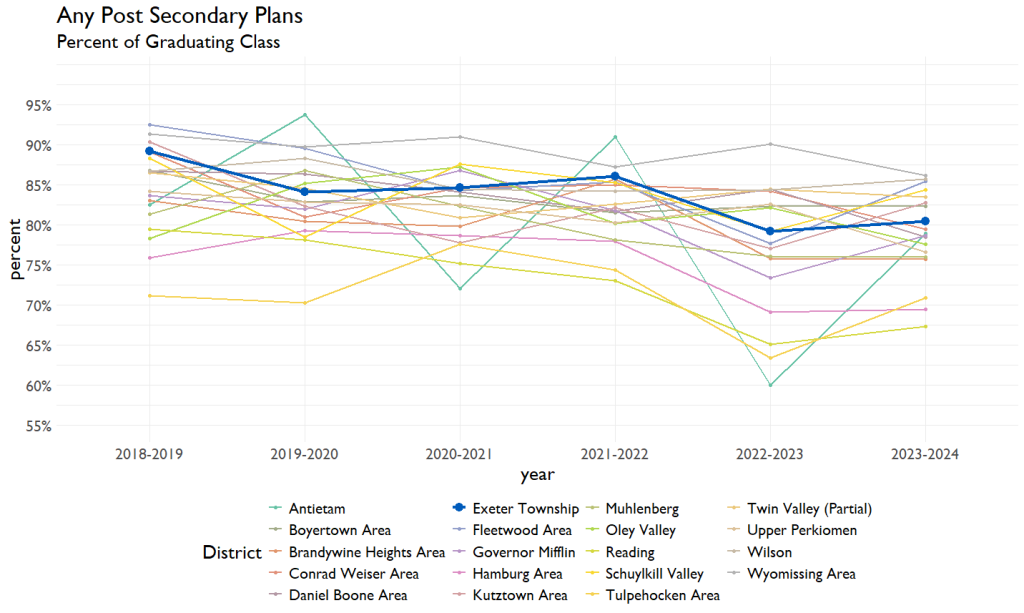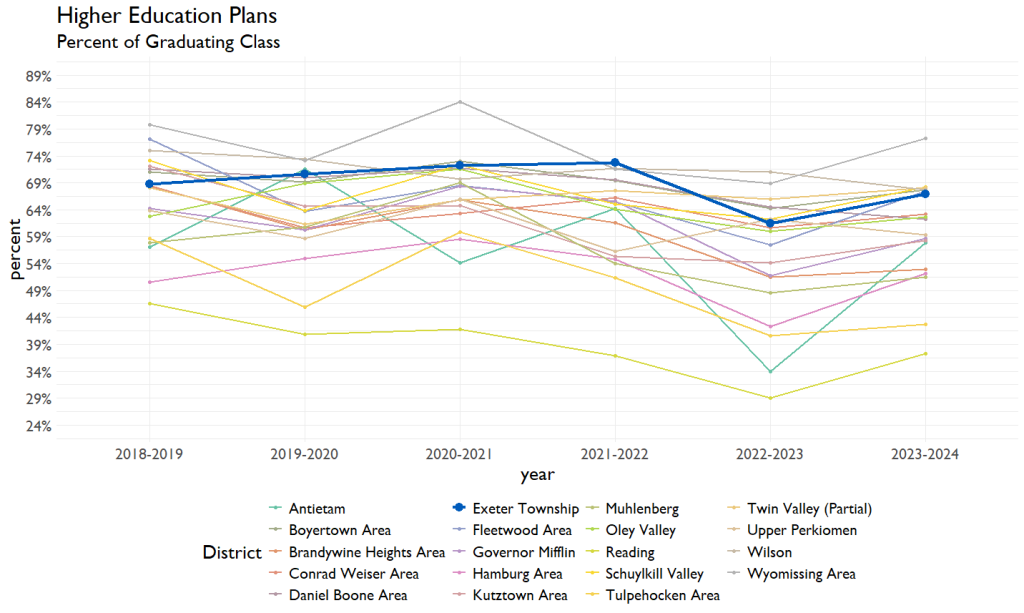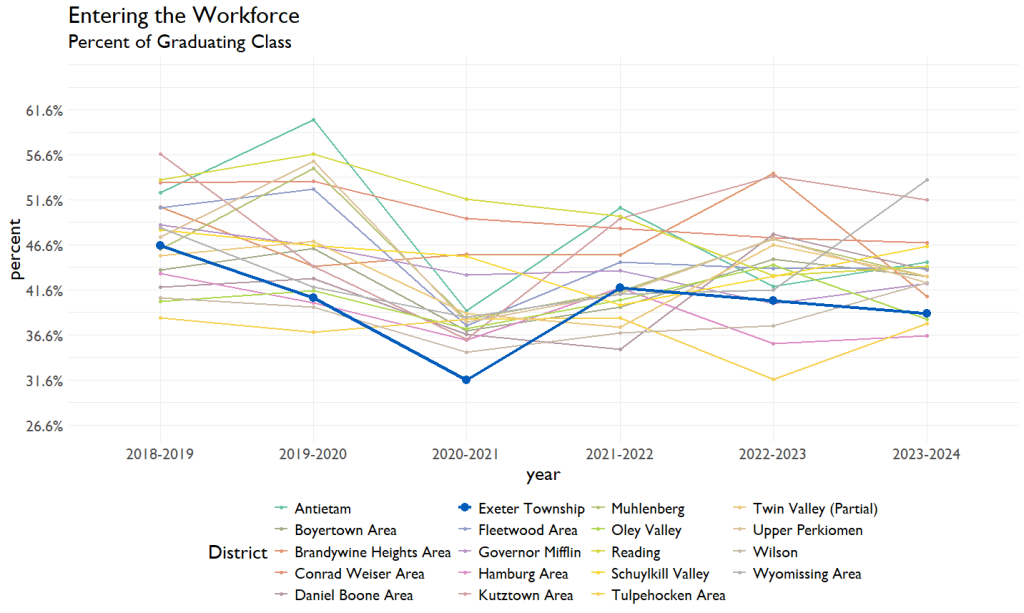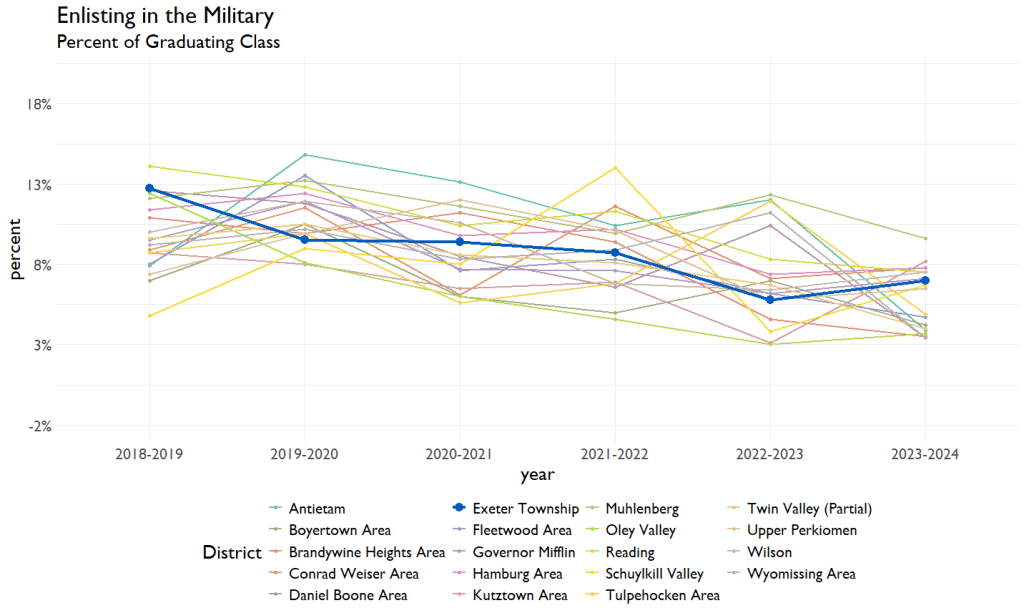
Is Exeter School District that Different from our Neighbors?
In our last post, we looked at what Exeter Township students shared about their post-graduation plans. A neighbor then asked how Exeter compares to nearby districts. While we couldn’t get as granular, since not all schools post this data on social media, we turned to publicly available data on the PA’s Future Ready site to examine school-level trends. This post examines how Exeter compares in four key areas: plans for higher education, entering the workforce, military enlistment, and whether students report having any plans at all.
Post-Secondary Plans

We started by looking at overall post-secondary plans—whether students reported any intention to attend college, join the workforce, or enlist in the military.
The results? Exeter’s students were not significantly different from their peers in other districts. Their reported plans were slightly higher in some categories and slightly lower in others, but none of these differences were statistically significant. What stood out more was a shared pattern across all districts: in recent years, fewer students have reported clear plans after graduation. The decline has been especially sharp in 2022–2023 and 2023–2024.
This trend suggests that the real story isn’t about how one district compares to another; it’s about a regional shift that may reflect changing opportunities, priorities, or barriers facing students as they prepare for life after high school.
Higher Education

Exeter Township students were slightly more likely to report plans to pursue higher education than their peers in other districts, but the difference wasn’t statistically significant. What stood out more clearly was a concerning downward trend across all districts, especially in 2022–2023. Fewer students are reporting college or university as their next step, a pattern that may reflect broader shifts in costs, value perceptions, or access.
Workforce Plans

Similarly, Exeter didn’t differ meaningfully from other districts in terms of students planning to enter the workforce right after high school. But once again, the larger story is regional: since 2020–2021, there’s been a steady decline in reported workforce plans. Fewer students are heading straight into jobs, suggesting that something is shifting in how they see their immediate post-graduation option
Military

There was no significant difference between Exeter and other districts in terms of military plans, either. However, the share of students reporting this pathway has dropped sharply in recent years, particularly in the 2022–2023 and 2023–2024 periods. This could indicate reduced interest, fewer recruitment efforts, or changes in eligibility and incentives.
Conclusions
To answer the question in the title: no, not really.
Exeter Township students report post-graduation plans at rates similar to their peers across nearby districts. Whether it’s college, the military, or entering the workforce, Exeter isn’t significantly different. The district aligns with broader regional patterns.
But while Exeter may not stand out, the trends themselves are worth watching. Across the board, fewer students are reporting clear next steps after graduation. These declines could reflect broader shifts, such as rising college costs, changes in the job market, or lingering impacts from the pandemic. As the path after high school becomes less predictable, schools and communities may need to offer more guidance, flexibility, and resources to help students move forward with confidence.
That said, it’s important to keep this analysis in perspective. First, the data only reflects students’ self-reported intentions, which may differ from what they actually do. Second, the statistical models adjust for year and district-level differences, but don’t include key factors like race, gender, family income, or access to programs like dual enrollment or career tech. These factors could shape student decisions in important ways that we couldn’t capture here. Finally, the sample sizes for some subgroups are small, which limits our ability to detect more subtle differences.
Still, despite these limitations, the findings offer a useful starting point: A way to identify broad patterns, raise the right questions, and continue the conversation about how we support students in planning their futures.
Stay Ahead of the Curve—Support Students with Confidence
If this deep dive helped you see student outcomes in a new light, imagine what you could do with curated, actionable insights delivered every week.
This Week in School Psychology is your go-to resource for breaking down the latest research in education and student mental health—so you can make informed decisions, drive real impact, and lead with purpose.
For just $5/month or $50/year, your subscription gives you:
- Plain-language summaries of cutting-edge research on youth development, mental health, and college & career readiness
- Early access to weekly insights that help you support students academically, emotionally, and socially
- A growing network of educators, psychologists, and changemakers who believe evidence should drive action, not gather dust
Want a sneak peek? Click here to view a free sample issue.
Whether you’re shaping policy, supporting students, or staying informed as a community leader, This Week in School Psychology equips you with the tools to stay ahead, without the jargon.



